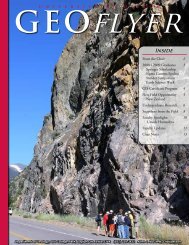Stander Symposium abstract book - University of Dayton
Stander Symposium abstract book - University of Dayton
Stander Symposium abstract book - University of Dayton
Create successful ePaper yourself
Turn your PDF publications into a flip-book with our unique Google optimized e-Paper software.
11:00 AM to 12:30 PM<br />
Mathematical Study <strong>of</strong> the Foot and Mouth Outbreak Model<br />
Presenter(s): Jungmi Johnson<br />
Advisor(s): Muhammad Usman<br />
Mathematics - Course Project, 12_SP_MTH_445_01<br />
The foot and mouth outbreak in the UK in 2001 was a disastrous event for the country and the economic. The disease did not only cost UK government<br />
so much money to stop the disease, but it also affected the tourism industry. Mathematical epidemic models can provide clear strategy for<br />
minimizing the effect <strong>of</strong> such a disease, determining the expected manner <strong>of</strong> its progression in the event <strong>of</strong> a future outbreak based upon the latest<br />
available data on the epidemic. This project is to explore how to minimize the cost, how to contain the disease in minimal time, and how realistic<br />
these models will be considering the limitation <strong>of</strong> the model. Numerical and qualitative tools such as MATLAB’s built in ode solver will be used.<br />
Numerical Study <strong>of</strong> a Mathematical Model <strong>of</strong> IL-2 Adoptive Immunotherapy on Patients<br />
with Metastatic Melanoma<br />
Presenter(s): Alyssa C Lesko<br />
Advisor(s): Muhammad Usman<br />
Mathematics - Independent Research<br />
IL-2 treatments have recently been identified to significantly reduce metastatic melanoma tumors and in some cases eliminate them. The problem<br />
with these treatments is that a set plan <strong>of</strong> administration varies from patient to patient and methods for determining treatment steps are still in<br />
the process <strong>of</strong> being developed. Previous research by Asad Usman and colleagues has used a numerical technique using MATLAB to decide treatment<br />
protocols. This research used the MATLAB’s built in ode15 function to addresses treatment procedures including the starting and stopping<br />
<strong>of</strong> each treatment and the period in between each treatment. Building on this data and existing model, my project will explore several other<br />
numerical techniques such as ode23 and ode45 solvers, Euler’s method, and the predictor corrector method to study IL-2 treatments in metastatic<br />
melanoma patients. A comparison will be made using error plots and tables, and a stability analysis using pplane7 will be investigated.<br />
Qualitative Study <strong>of</strong> an SIR epidemic model with an asymptotically homogeneous<br />
transmission function<br />
Presenter(s): Karoline E H<strong>of</strong>fman<br />
Advisor(s): Muhammad Usman<br />
Mathematics - Course Project, 12_SP_MTH_445_01<br />
I will be exploring and analyzing an SIR epidemic model. This particular model has an asymptotically homogeneous transmission function which<br />
means the transmission rate is proportional to the fraction <strong>of</strong> the number <strong>of</strong> infective individuals to the total population. I will also look at a<br />
qualitative analysis <strong>of</strong> the model and then discuss the implications <strong>of</strong> the results <strong>of</strong> the model.<br />
Adopting a Policy <strong>of</strong> Sustainable Landscaping on UD’s Campus<br />
Presenter(s): Kevin M Sullivan<br />
Advisor(s): Daniel C Fouke<br />
Philosophy - Course Project, 11_FA_SEE_401_H1<br />
The campus <strong>of</strong> the <strong>University</strong> <strong>of</strong> <strong>Dayton</strong> is one which is lacking in biodiversity and species richness. This was noticed by students in SEE 401 and targeted<br />
as a problem. In order to help restore biodiversity to the campus, four <strong>of</strong> the students drafted a proposal to the university on the importance<br />
<strong>of</strong> biodiversity on campus as well as on the earth. Much research was done concerning ecosystem services, human impact on the environment,<br />
invasive species, pollinators, and the benefits <strong>of</strong> native plants. After the research was conducted, it was concluded that the health <strong>of</strong> the campus,<br />
as well as the surrounding ecosystem, would benefit from focusing attention on restoring biodiversity, and that adopting a policy <strong>of</strong> planting<br />
native plants, as opposed to foreign plants, would be the best option. In addition to drafting a proposal on planting native plants, a pilot project<br />
was also formed, which was a direct plan to bring specific native plants to a specific area on campus. The exact location is a small wetland near<br />
Art Street on Frericks. Also, in addition to planting native plants, adopting sustainable landscaping practices, including “xeriscaping,” was included<br />
in the proposal, as it goes hand in hand with helping the campus. The said proposal was submitted to the university Grounds Crew on 12/16/11.<br />
88

















